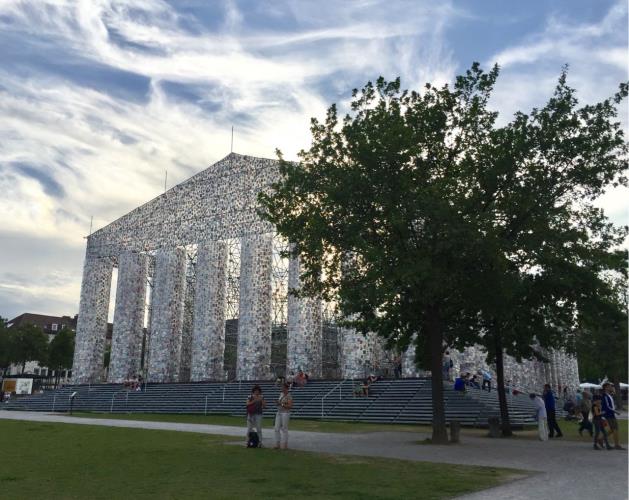Bachelor's degree with a double major in Chinese and Art in Peking University. Master of Art and Administration in New York University. She has served in the Macao Cultural Affairs Bureau, the New York City Department of Cultural Affairs and the Museum of Chinese in America, working as art administrator and curator. She is now working as an art educator and administrator in New York, as well as an independent curator and writer.

The Parthenon of Books and the first oak tree planted by Joseph Beuys on Friedrich Square
I may not have come to Kassel with a worship attitude if it is not Kassel Documenta. Kassel is the third largest city of Hesse State of Germany and it is most famous for Kassel Documenta in addition to Bergpark Wilhelmshöhe listed as a world heritage by UN.
Kassel Documenta was given birth ten years after Nazi regime collapsed, namely, in 1955. The exhibition was aimed to free arts again and modern works of art which could not be showcased during the Nazi period were exhibited, so the first exhibition attracted 130,000 visitors. After that, the exhibition is substantially held once every five years and had gradually developed as the exhibition platform for contemporary arts.
At the nightfall when I first arrived in Kassel, I was guided by the exhibition guide application on my cell phone to see numerous public works of art kept in the city because of the exhibition. These works led me to reach streets and alleys, experiencing splendid natural landscape of the garden city. In addition to introducing the meaning and creator, the voice guide software also emphasised the year when the creator presented his or her works at the exhibition. From the narration with a time span, I recognised that the history and importance of the exhibition and avant-garde arts many years before have become important cultural assets of Kassel.
Visitors of the exhibition were more than I imagined and most of them are old aged couples and parents bringing their children, but contents of the exhibition could not said to be suitable for persons at all age levels. One of the works greatly impressing me is the Warsaw artist Artur Żmijewski: his series videos record many strong but disabled men who were exercising. In the German context, people can easily imagine harm by war to individuals from such videos. These works I can’t stand the sight of are many at the exhibition; they are from the third world, edge of society and forgotten historical scene and undisguised, sharp, hard to understand or even simple, but what astonished me is that tens of thousands of people came to the exhibition from thousands of miles away just for the purpose of facing the query to them from the works.
Such serious speculation is undoubtedly boring and visitors may feel a little relaxed when they exited the main venue Museum Fridericianum and take a look at the pleasing garden landscape on the square. But actually even each oak tree with a plain shape on the square is a work of art created by an artist engaged in the society. At the 7th Kassel Documenta in 1982, the artist Joseph Beuys planted the first oak tree on the square and in five years after that 7,000 oak trees were planted on the streets in Kassel. Beuys promoted the ideal of “city foresting” by using such plan and he hoped to improve the society into a kind of art and improve the society with art.
Over thirty years later, those 7,000 oak trees still benefit Kassel’s citizens and tourists today. I can’t help being surprised by the change to the city from art and I also admired the field inspiring introspection which had been created by the exhibition over sixty years ago. It cultivated the new generation people and led Europe’s contemporary humanistic spirit. After viewing many historical cities and famous museums, I found that the small city of Kassel made me truly experienced the true European culture and history.
For the exhibition, the Argentina artist Marta Minujín’s work The Parthenon of Books was rebuilt on Friedrich Square. The building is like the grand Parthenon when seen from a long distance away, but when seen closely it consists of the walls even built with one-hundred thousand books. If you have interest in further study the work, you would know that all of these books are banned ones from all over the world. The representation of the work interpreted the curator’s message about the exhibition and current society – human beings’ independent thoughts and introspection capability build those great and impressive temples in human history.